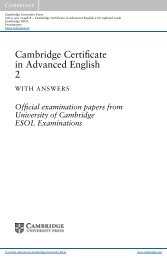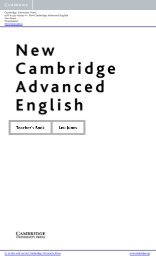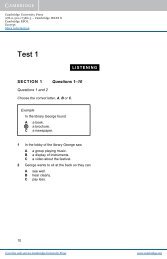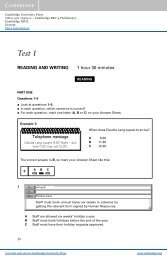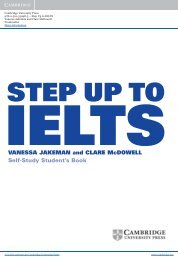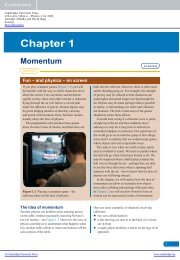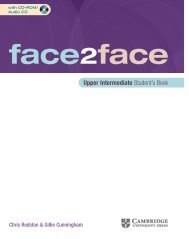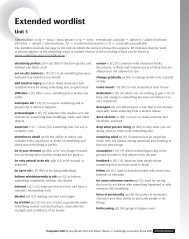Skills for Study Level 2 Teacher's Book - Cambridge University Press
Skills for Study Level 2 Teacher's Book - Cambridge University Press
Skills for Study Level 2 Teacher's Book - Cambridge University Press
Create successful ePaper yourself
Turn your PDF publications into a flip-book with our unique Google optimized e-Paper software.
2fAnswers1 Speaker 1 gives an explicit, numbered reference to the graphic. Speaker 2doesn’t mention the graphic at all.2 Speaker 1 presents the in<strong>for</strong>mation more effectively, commenting on thetrends and what they suggest. Speaker 2 is briefer and less explicit. Thecomment about what the findings show is simultaneously very brief andoverly confident <strong>for</strong> what the results actually suggest.2g Group discussion2h Students read and take notes of the relationship between the two variables thatthey expect.2i Students check their answers with a partner.2j Students in pairs take turns presenting in<strong>for</strong>mation to each other.2k Students give their partner feedback.3 Discussing research findings3a Group discussionSuggested answers1 No. It should not just be about looking <strong>for</strong> negative points.2 No. The discussion is best if as many people as possible can contribute.3 Probably true. It will at least be very difficult to contribute if the presentationis ignored.4 Yes. This helps consolidate understanding of the topic.5 Yes. Just as <strong>for</strong> point 4 above.6 Yes. Just as <strong>for</strong> point 4 above. This also helps to generate ideas aboutfuture studies.3b Student discussion3c Note: This discussion is based on the research findings about lighting in 2h.4.6Suggested answersThis seems to be a reasonable discussion: the speakers make valid pointsabout the implications of the findings, and potential limitations, giving thepresenter a chance to explain their own ideas. Between them they manage toidentify some areas where future research might be needed.3d Students think of comments or questions that they could contribute to thediscussion in 3c.Unit Task: Designing buildings <strong>for</strong> human needsabcStudents should be encouraged at this point to gather as much data as possible tobe able to share in the discussion.Students, in groups of 3–4, hold a discussion about different aspects of their chosenassignment title.After the discussion, students reflect on how much they accept the in<strong>for</strong>mation and anyclaims they heard, and whether they have altered their own stance on the topic as a result.Note: Ask students to turn to the checklist on p.241 and reread the tips relating toUnit 4 Parts A–C, be<strong>for</strong>e reading the tips to Unit 4 Part D. Encourage students to putthese tips into practice in their studies from now on. Tell them they will be asked toreport back on this in a future lesson.Unit 4 Part D ∙ Reporting in speech 126



